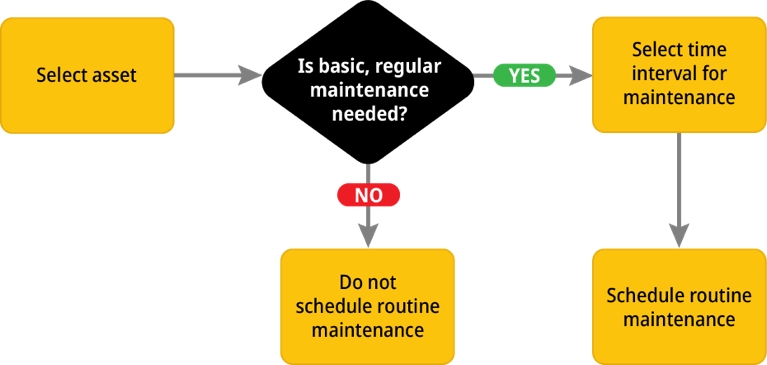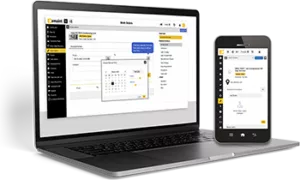
What Is Routine Maintenance?
Routine maintenance refers to the performance of consistently scheduled tasks to ensure the optimal functioning and longevity of equipment and facilities. These tasks, done at regular intervals, help identify and address potential issues before they lead to costly failures. Just a few examples of routine maintenance include inspecting and servicing machinery, replenishing supplies in restrooms, and conducting safety checks.

Most of the time, routine maintenance plans are calendar-based. For example, certain parts might need to be replaced every six months. But some routine maintenance tasks are usage-based, like changing a car’s oil after driving 3,000 miles.
Done right, routine maintenance can prevent or catch potential problems early on, while they are still easy to fix. Most routine maintenance tasks are simple enough for machine operators to do on their own, which leaves your technicians free to focus on more complex work.
By adhering to a routine maintenance schedule, businesses can increase efficiency, reduce downtime, and extend the lifespan of their assets. In a 2021 study, manufacturers who relied on proactive strategies over reactive maintenance experienced nearly 53% less unplanned downtime and nearly 79% fewer defects.
Examples of Routine Maintenance Activities
Examples of routine maintenance tasks include:
- Lubricating, adjusting, or cleaning equipment
- Inspecting equipment for proper operation and safety
- Replacing worn or deteriorating parts
- Checking and maintaining safety equipment like fire extinguishers and alarm systems
- Replacing damaged signage or utilities, such as light bulbs
- General workplace maintenance, including cleaning floors, replacing HVAC filters, washing windows, trash removal, and landscaping
By regularly performing these simple tasks, you can ensure equipment longevity and a safe working environment.
Types of Routine Maintenance
Routine maintenance consists of multiple categories. While each one has a unique focus, all types of these routine tasks share the same goals:
- Optimize equipment performance
- Identify potential safety hazards for machine operators
- Prevent unexpected downtime
- Avoid costly emergency repairs
- Extend the working lifespan of your equipment
Time-Based Maintenance (TBM)
TBM follows a regular upkeep schedule with machine servicing based on specific times or intervals. This includes specific due dates (for example, daily tasks like trash removal) as well as key usage indicators (for example, maintenance for every 200 hours of active use). The latter is sometimes referred to as usage-based maintenance.
Failure-Finding Maintenance (FFM)
This type of routine maintenance aims to identify failures that maintenance technicians may not find in regular inspections. This includes lesser-used components such as safety equipment.
For example, safety valves aren’t part of regular operations; they’re a failsafe measure. And while they don’t wear out as quickly, these assets still require routine inspection and maintenance to perform essential functions reliably.
Risk-Based Maintenance (RBM)
Like FFM, RBM also prioritizes maintenance requests based on potential failures. But RBM encompasses all types of assets (not just those that are scarcely used). And with RBM, teams evaluate each asset’s likelihood of failure, along with the projected impact of failure, to determine priority.
Without a reliable way to analyze maintenance data and assess risk, this method is challenging. That’s why successful RBM requires storing maintenance data within a robust computerized maintenance management system (CMMS), such as eMaint.
Condition-Based Maintenance (CBM)
This type of routine maintenance relies on detailed, real-time data sets to assess the performance and condition of each asset. With condition-based maintenance, teams use live equipment monitoring to identify anomalies and schedule maintenance work orders before failure ever occurs.
A comprehensive software solution, such as a CMMS, is essential for efficient condition-based maintenance. Automatic alerts remove uncertainty and reduce your team’s administrative workload, while automated work orders shorten the time needed to fix assets in response to each alert.
For reliable asset performance with minimal downtime, incorporate multiple routine maintenance workflows into your schedule.
Routine Maintenance vs. Other Maintenance Strategies
When teams only address existing problems with equipment and assets, that’s reactive maintenance. Performing maintenance this way can result in more downtime, more difficulty planning efficient schedules, and higher costs (such as when damaged parts cannot be repaired and must be fully replaced).
Teams must also practice proactive maintenance strategies, such as a routine maintenance program. So, apart from routine maintenance, what are the other types of proactive maintenance strategies?
Preventive Maintenance (PM)
As you might guess from the name, preventive maintenance is made up of regular maintenance tasks designed to prevent equipment failure. With this method (also known as preventative maintenance), teams enable consistent operations, anticipate future issues, and avoid asset breakdowns.
Planned Maintenance
This form of maintenance is essentially preventive maintenance on a larger scale, with greater complexity. The goal is similar: to avoid future asset failures.
But planned maintenance (also known as scheduled maintenance) often includes scheduled downtime, which allows teams to perform more complex or specialized maintenance processes. This downtime also enables thorough equipment inspections before and after scheduled maintenance tasks.
Planned maintenance tasks may require specialized skills and are more time-consuming than preventive maintenancetasks, but they typically occur less frequently.
Predictive Maintenance
When the maintenance department uses real-time data to evaluate asset health and anticipate when equipment will require attention, it’s known as predictive maintenance.
While similar to condition-based maintenance, there’s a key difference. The aim of predictive maintenance is to perform maintenance before asset degradation occurs. Condition-based maintenance, on the other hand, may be performed when assets begin to degrade (but before they fail).
Reliability-Centered Maintenance (RCM)
Reliability-centered maintenance focuses on a combination of uptime and asset repair, rather than replacement. With this approach, the maintenance department aims to replace assets less frequently by reducing the chance of failure. When performed efficiently, RCM can reduce maintenance costs.
Advantages of a Routine Maintenance Schedule
Routine maintenance is a vital part of any preventive maintenance strategy. It can save your operation from the expense, stress, and unplanned downtime that typically comes with a reactive maintenance approach.
The most significant benefit of a routine maintenance schedule is increased reliability. Routine maintenance ensures that your assets stay up and running for longer. And when there’s a problem, regular inspections catch it early so you aren’t blindsided in the middle of your busy production cycle.
Routine maintenance has several advantages beyond reliability, too. Staying on top of routine maintenance can:
Save Money on Maintenance
It’s like the old saying – a stitch in time saves nine. By keeping a maintenance checklist and performing minor maintenance tasks on an ongoing basis, you can help prevent unexpected failures. That means you won’t need to call in your technicians for extensive, costly repairs.
Increase Maintenance Team Productivity
Machines that are regularly serviced perform better. By regularly changing parts, lubricating, and cleaning components, you’ll ensure that your assets stay in top condition. You won’t have to deal with unexpected breakdowns. You also won’t face slowdowns or reductions in product quality.
Help with Inventory Planning and Scheduling
Sticking to a maintenance routine means you know what to expect. This makes inventory and scheduling much easier.
How Does Routine Maintenance Decrease Downtime?
Routine maintenance can dramatically decrease unplanned downtime. By regularly servicing machinery, teams can prevent sudden breakdowns. Routine maintenance also protects against slowdowns by keeping equipment in top running condition.
Perform Routine Maintenance to Identify Problems Early
Inspecting machinery is an important part of routine maintenance. Depending on the machinery, maintenance workers will test its condition monthly, quarterly, or annually. This ensures your team will spot the first signs of a new machine fault.
Conducting such routine maintenance gives technicians plenty of time to repair a fault before they are forced to take the asset offline.
Perform Routine Maintenance to Extend Equipment Lifespan
Over time, excess wear and tear can cause severe machine defects. Routine maintenance helps prevent this.
Proper lubrication protects assets from friction and overheating. And performing checks and adjustments can fix imbalance issues. Regular cleaning, replacing deteriorating parts, and changing filters also help keep your critical assets up and running longer.
How to Maximize Routine Maintenance
There are a few key factors that can take routine maintenance to the next level:
Optimizing scheduling for each asset. It’s important to figure out exactly how often each machine needs adjusting, cleaning, and lubrication. It’s also important to figure out exactly how often each part needs to be changed.
Assigning responsibility. Maintenance works best when one team member is in charge of each task. Otherwise, there’s a risk that jobs will slip through the cracks.
Putting quality checks in place. Set up the means to check whether tasks are being completed correctly.
Getting the timing right. Where possible, schedule routine maintenance tasks for times when your machines are already offline. If you need to schedule repairs, find a time when your technicians are already on location.
Routine Maintenance Work FAQs
What Is Routine Maintenance?
Routine maintenance is a proactive strategy for preventing equipment failure. It consists of regularly scheduled service tasks to keep assets at peak performance.
Routine maintenance tasks typically follow a time-based schedule, such as weekly, monthly, or annually. However, they may also follow a usage-based schedule, like changing your car’s oil every 3,000 miles.
What Are the 4 Types of Maintenance Activities?
Apart from routine maintenance, there are 4 other common types of proactive, consistent maintenance:
- Preventive maintenance (PM): PM anticipates issues to prevent equipment failure and keep assets operational.
- Planned maintenance: Planned maintenance involves large-scale, complex, or specialized tasks that may include scheduled downtime for maintenance and inspection.
- Predictive maintenance: Teams use real-time data to evaluate asset health, anticipate needs, and conduct maintenance before assets begin to degrade.
- Reliability-centered maintenance (RCM): RCM prioritizes asset repair (rather than costly replacement) as well as maximal uptime.
What Is to Be Checked in Routine Maintenance?
Routine maintenance tasks typically involve standard cleanings, inspections to assess health and performance, and execution of minor repairs.
Wondering what else to check? Manufacturer guidelines for your equipment can inform your routine maintenance workflow.
How eMaint CMMS Supports Routine Maintenance
eMaint CMMS provides the tools, the structure, and the insights to take routine maintenance to the next level.
eMaint reporting capabilities give you valuable insights into each asset’s needs. For example, it’s easy to run a query on how often each asset needs lubrication, shaft adjustment, or a new belt. You can then use those insights to build and schedule the optimal routine maintenance plan.
eMaint can also greatly help with scheduling. The software tracks your existing maintenance jobs and available team members. eMaint can even assign jobs to specific people based on their skills and expertise. Best of all, eMaint can automatically generate work orders, and managers can build in routine maintenance checklists and benchmarks to ensure that every job gets done right.
The result? Increased uptime and lower operational costs.


